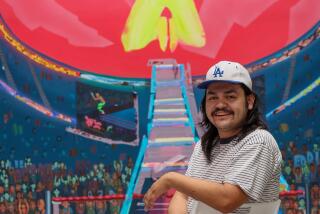Translating Modern Hieroglyphics Into a Community Portrait
Until recently, the maze of graffiti covering Van Pfister’s service station was so ugly that the city of San Fernando issued the station’s parent company a citation for its unattractiveness.
Pfister, who has owned the combination gas station and snack bar at the corner of Laurel Canyon Boulevard and Rinaldi Street for two years, says he would paint sections of the station by day only to have its walls covered with graffiti the same night, courtesy of local tagging crews.
When a Unocal representative paid a personal visit and warned Pfister to keep the station graffiti-free or the company would have to pay a fine, Pfister was appalled.
“I told him I came to run a business, not be a painter,” said Pfister, who had resorted to late-night painting sessions so the station would be presentable by first light. “I was up to here,” he said, bringing his right hand up to his forehead.
Friends told him he had three options: Hire armed security guards, catch the taggers and cover them with their own spray paint, or simply shoot them.
None seemed realistic to him.
“I never really thought about doing any of those things,” said the bespectacled, mild-mannered Pfister, 53. “The worst I ever thought was that I’d like to put them over my knee and spank them.”
Finally, after two years of frustration, sleepless nights spent guarding the station and approximately $400 a month to buy white paint, Pfister contacted a local youth center last month and agreed to donate the 10-by-25-foot back wall of his station to local taggers, so they could create a mural.
Never mind, Pfister said, that some of these kids were probably the same ones who had marred his building with their artless scrawls. It was time for a thaw in this small Cold War.
On Saturday, as he watched teen-age boys and girls representing 12 of the neighborhood’s 37 tagging crews working over the wall of his station, Pfister beamed like a proud father.
“Did you see it?” he asked, referring to the work in progress. “It’s beautiful, isn’t it?”
Replacing the hieroglyphics-like tags--by which those in the know learn just how prolific certain crews or individuals are and how much respect they are afforded by rivals--was a brightly colored mural of large, block-style letters that would read “Respect, Peace and Pride in the Neighborhood.”
The 15 taggers-turned-artists took turns whitewashing, spray-painting and discussing where and what to paint. Later, they would each add their name to a scroll accompanying the mural.
For their part, the kids, who range from 13 to 18 years old, steadfastly maintained that they are artists--graffiti artists--not “tag bangers,” gang members or street thugs. They said they are misunderstood.
“Everybody’s saying that we’re destroying the city,” said Juan Adams, 18, who, like the others, wears the baggy pants, T-shirt and backward baseball cap that has become the uniform of many urban teens. “We’re showing them that we can do something positive.”
And despite belonging to crews with names like Insane Crime Unit, better known as ICU, and Unstoppable Criminals, the teen-agers say they are dangerous only to flat surfaces and the egos of rival taggers.
“It’s the newer kids who tag to try to copy us that are into gangs,” said 15-year-old Carlos. “We’re from the old school. If we want to take you out, we’ll take you out with our writing.”
“In our own way, we’re gifted. Not everybody can do this,” chimed in Ivan, also 15. If owners of other graffiti-plagued buildings “see what we are doing and they like it, we can do it for them too.”
Indeed, the owners of two stores next to Pfister’s service station have agreed to let the kids paint murals over their graffiti-scarred walls, said the mural project’s organizer, Charles Avelar, who coordinates the Graffiti Arts Alternative Program of New Directions for Youth, a social service agency in Van Nuys.
Avelar is a godfather of sorts to the taggers. Every single one of dozens of kids in the program has been referred there by the probation agency because they were caught tagging.
“We talk about what it feels like to be called animals and dogs and to be put down in general,” Avelar said of the group’s weekly meetings. “They get disrespected, so they show the neighborhood disrespect. What else do people expect? We’ve got to come halfway with them.”
While all agree that it is too early to tell if painting murals will be enough of an outlet to prevent them from defacing the property of unwilling hosts, the teen-agers admit to being inexorably drawn to cans of Krylon and unspoiled facades.
“It’s like a religion or a drug for us,” said one teen, trying to explain.
And the surfaces of the neighborhood are testament to the addictive power of tagging. Tags covers walls, street signs, fences, telephone poles, sidewalks, freeway overpasses, even cars.
Asked if he would refrain from tagging after helping create the mural, Carlos was noncommittal.
“I don’t know. Probably not this one because I helped make it.”
Pfister--who agreed to let other tagging crews paint a new mural on the same wall every two months or so--hopes taggers will now respect his station.
“I am hopeful about this,” he said, forcing a smile. “We’ll all just have to wait and see what happens.”
Then a man drove up, looked at the group of painters, and said: “It’s about time you kids did something right.”
The taggers stopped, smiled and nodded in agreement.
More to Read
Sign up for Essential California
The most important California stories and recommendations in your inbox every morning.
You may occasionally receive promotional content from the Los Angeles Times.










